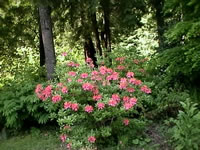How to Transplant Azaleas, Rhododendrons and other Small Shrubs
              
"I have several large (about 3ft tall), old (about 5 years) azaleas that I want to move.
Can azaleas be moved? How? When?"
Azaleas can be transplanted successfully during almost any season of the year but in the early fall,
at the beginning of their dormant period, is the best time.
Here is the procedure I try to follow....
Transplanting Azaleas and Small Shrubs |
|
|
- Dig your new hole about 2 feet deep, and 1 foot wider each way than the full spread of the root ball of the plant (this larger hole will benefit the rapid regrowth of the roots).
- Mix in a generous amount of peat moss and compost and
a handful of transplant food to the soil you have removed.
- Fill the hole with water.
- Take a sharp shovel, and cut a circular narrow trench (cutting the roots cleanly) at the drip line of the plant you are going to move, making your cuts as vertical as possible, and about 12-18 inches deep.
- If possible, get some help, and using 2 or 3 shovels positioned evenly around the plant, simultaneously apply lever pressure to the shovels. The plant should "POP" up out of the hole.
- Get some help, and remove the plant from the hole, and into a wheelbarrow, or tarp. Transport it to your prepared hole.
- Set the plant into the hole, adding or removing soil so that the plant is as close as possible to the depth at which it was previously growing.
- Turn the plant in the hole so that it presents its best side toward the area it will be viewed from.
- Again, fill the hole with water, and then begin to add the soil to the hole. Yes, you will have a muddy mess, but this will insure that there are no air pockets around the roots.
- Apply a mulch if desired.
|
Step back and admire your work,,,next spring its going to look great!
|
For more general care of Azaleas, go to Azalea Care
Exbury Azalea
 |
|
|
|
Search The Garden Helper:
